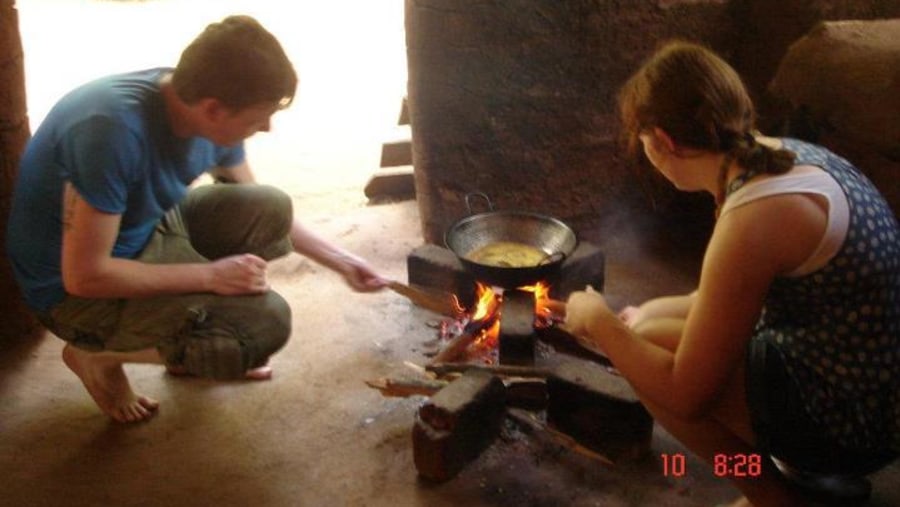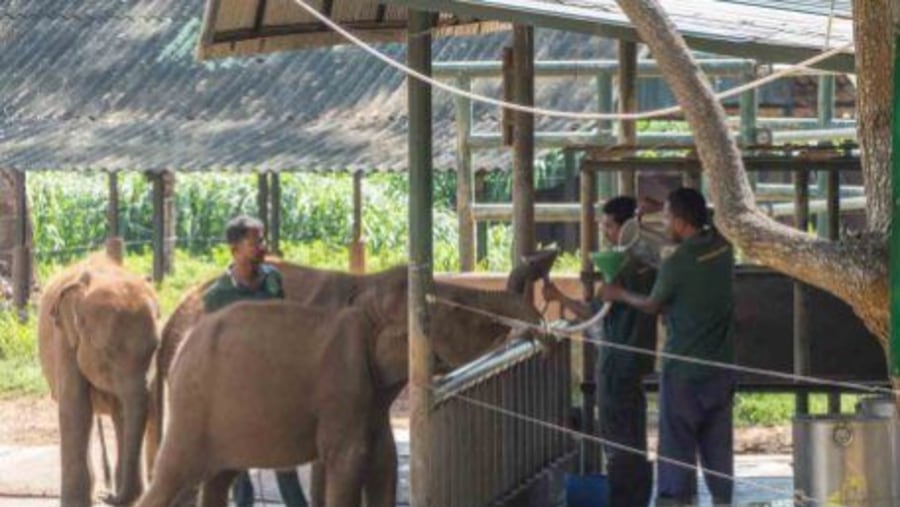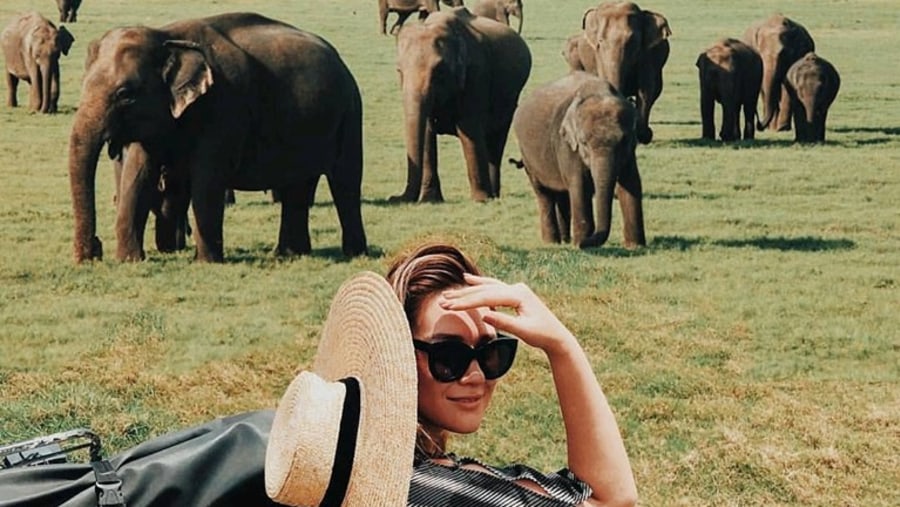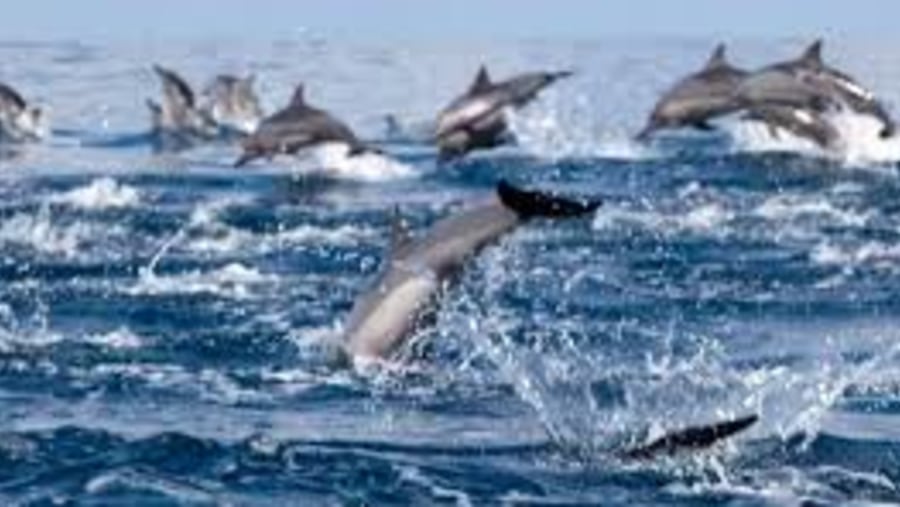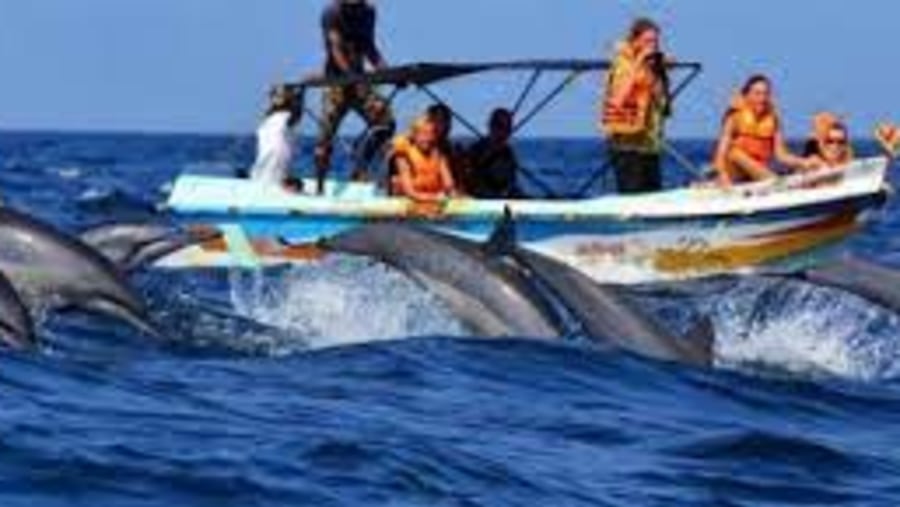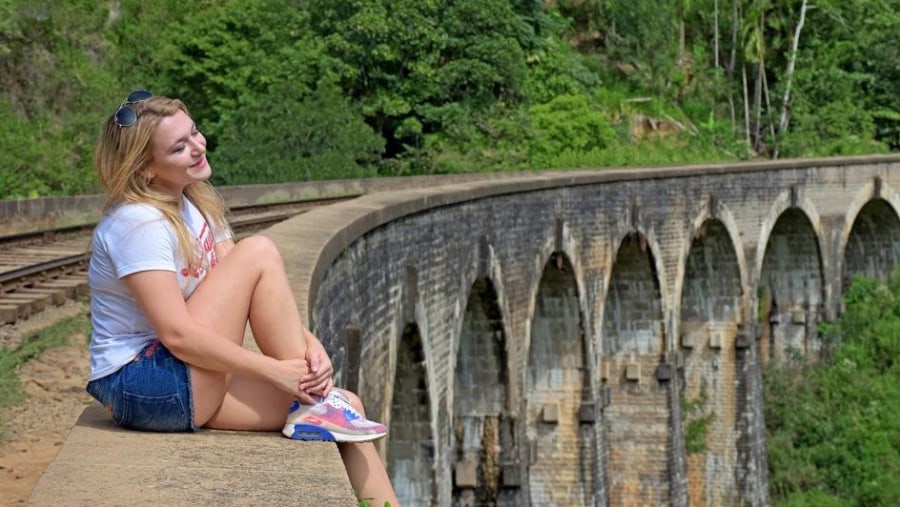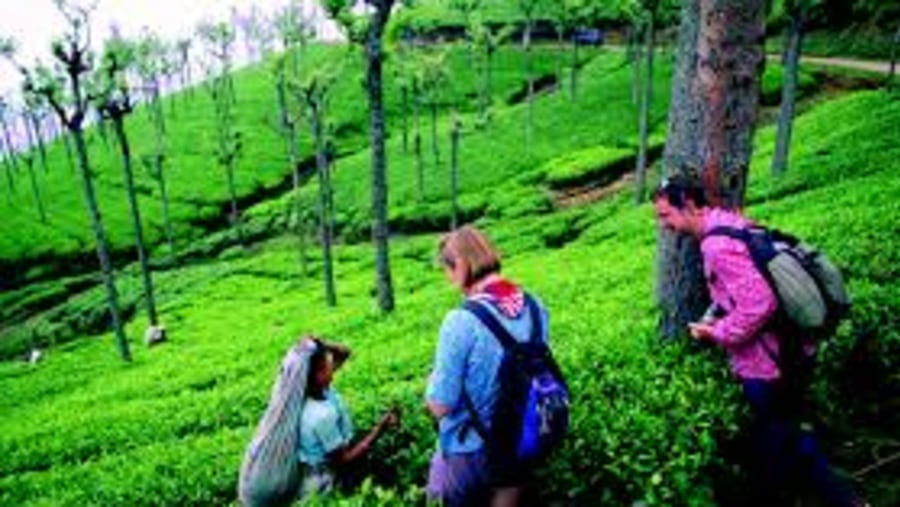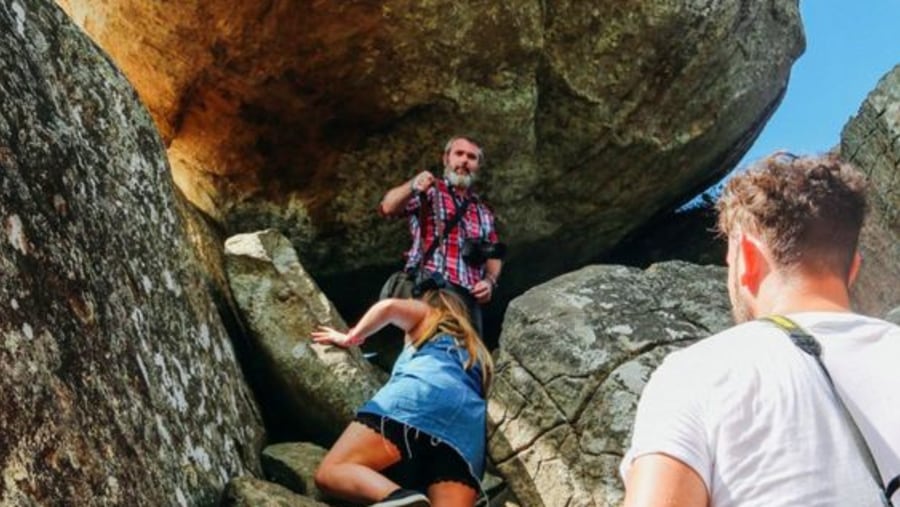Nature Secret Sri Lanka
Description
Explore the main attractions of Sri Lanka such as Sigiriya, Polonnaruwa, and Anuradhapura. Enjoy game drives in Minneriya National Park, Yala National Park, and Wilpattu National Park. Adore the whales and dolphins at Mirissa while whale and dolphin watching. Visit the town of Trincomalee.
Highlights
- Visit the Dambulla Cave Temple and the Temple of the Tooth Relic
- Climb the Sigiriya Rock Fortress and Pidurangala
- Meet adorable elephants at the Pinnawala Elephant Orphanage
- See the Nine Arch Bridge in Ella
- Take a dip in the Raven Waterfall
- Relax at the Nilaveli Beach
- Enjoy shopping in Colombo
- Ride on the Madu Ganga River on the boat
Itinerary Expand All Collapse All
-
Day 1: Arrive in Colombo expand_more
- Our staff will be there to welcome you at the Airport warmly.
- Get picked up and transferred to stay in a Luxury Hotel close to Colombo.
- In the evening, get a short brief for your knowledge every day for the next day's activities & try to finish at 5.00pm.
Overnight stay at the hotel
-
Day 2: Colombo expand_more
- The next day, after breakfast, enjoy the City tour of Colombo.
- Visit Dutch Hospital, Colombo National Museum, Zoo Dehiwala & Gangaramaya Temple.
- In the evening, discuss the next day's plan of activities with the tour guide.
Overnight stay in Colombo.
Colombo is the commercial capital and largest city of Sri Lanka by population. According to the Brookings Institution, Colombo metropolitan area has a population of 5.6 million, and 752,993 in the city proper. It is the financial center of the island and a tourist destination. Sri Jayewardenepura Kotte, commonly known as Kotte, is the official administrative capital of Sri Lanka. Sri Jayewardenepura Kotte is a satellite city.
-
Day 3: Balapitiya expand_more
- Early morning at 6.30 am after breakfast, transfer down south beachside.
- En-route visit Turtle Farm in Ahungalla.
- Visit Balapitiya and enjoy the Maduganga river safari.
- Visit the Mask Factory in Ambalangoda and the Moonstone mine at Meetiyagoda.
- In the evening, discuss the next day's plan of activities with the tour guide.
- Relax in the hotel.
Overnight stay at a hotel in Balapitiya
Ahungalla Turtle is the most commonly found turtle in Sri Lanka. They are also found in the Indian, Pacific and Atlantic Oceans. Their English name refers to the colour of the fat found under their shells, which unfortunately is used to make turtle soup. Luckily this practice is less common today. Young Green Turtles are mainly carnivores. Adults however are herbivores, feeding only on marine vegetation with the help of their finely serrated jaws. They grow to a maximum length of 1m and can weigh 250kg. Adult females lay between 120-140 eggs at one time. Green Turtles are regularly found on the beach at night close to the KSTCP. They tend to nest only every few years but when they do they lay several times in one season.
Madu Ganga is the second biggest wetland in Sri Lanka. The estuary is spread over 900 hectares of which 770 hectares are covered with water and is inhabited with 64 islands of which 15 islands have a larger landmass. Abundantly rich in biodiversity, in the area surrounding the Madu River you’ll find swampy marshlands covered in mangrove forests. It is also home to 300 species of plants and about 250 wildlife species.
Ambalangoda Mask making is a popular tradition in Sri Lanka. Many Sri Lankan mask artisans ply their trade along the Western, South Western and Southern coasts of the island. Of these, the Ambalangoda area on the South Western coast of Sri Lanka is renowned for its talented artisans. Ambalangoda that famed for its history and expertise in mask carving and culture. And the best place to get your fill of mask lore is the Ambalangoda Mask Workshop and Museum in Sri Lanka.
Meetiyagoda also spelt Mitiyagoda, is situated only 4 km distance from the ocean, 10 km north of Hikkaduwa. Meetiyagoda is famous for its moonstone mines. Moonstone has been used in jewellery for millennia, including ancient civilizations. The Romans admired moonstone, as they believed it was derived from solidified rays of the Moon Both the Romans and Greeks associated moonstone with their lunar deities. In more recent history, moonstone became popular during the Art Nouveau period; French goldsmith René Lalique and many others created a large quantity of jewellery using this stone.
-
Day 4: Unawatuna expand_more
- Leave from Balapitiya at 7.00 am to Unawatuna after breakfast.
- En-route, visit Dutch Fort, a UNESCO World Heritage Site.
- Watch the stilt fishermen who make the activity seem easy and comfortable.
- Visit the WallaDevalaya in Unawatuna.
- Return to the hotel.
- In the evening, discuss the next day's plan of activities with the tour guide.
Overnight stay at hotel Unawatuna
Early morning travel to the Dutch Fort: Portuguese built the first fort to withstand attack from the Sri Lankan kingdoms to the north. The Dutch entrance to the fort with its VOC with 1669 carve in the inner archway is still in use
Galle Fort, in the Bay of Galle on the southwest coast of Sri Lanka, was built first in 1588 by the Portuguese, and then extensively fortified by the Dutch during the 17th century from 1649 onwards. It is a historical, archaeological and architectural heritage monument, which even after more than 432 years maintains a polished appearance, due to extensive reconstruction work done by the Archaeological Department of Sri Lanka. The heritage value of the fort has been recognized by the UNESCO and the site has been inscribed as a cultural heritage UNESCO World Heritage Site under criteria iv, for its unique exposition of "an urban ensemble which illustrates the interaction of European architecture and South Asian traditions from the 16th to the 19th centuries
Unawatuna, Lovers paradise, lovely beach and activities Unawatuna is one of the biggest tourist destinations in Sri Lanka and is the most “famous” beach in the country. It is a lovely banana-shaped beach of golden sand and turquoise water, surrounded by green palm trees! Its beach and corals. Unawatuna is rich in its biodiversity. Its greatest potential attraction for eco-tourism was the marshland or mangrove, Kadolana, which was partially dredged and filled to develop a hotel for a German hotel chain. The development never eventuated. Many locals believe it to have been cursed for being built at the doorstep of the Wella Devalaya. Weligama, beach is famous for its stilt fishermen. In chest-deep water on the beach, just a few meters off-shore, are the stilt fishermen perched on a crossbar- one on one- of a single pole planted into the sea-bed. These fishermen, the poorest of the poor, spend hours with their lines cast out to the sea to catch small fish. Stilt Fishing is one of the most interesting traditional fishing methods of Sri Lanka. Records indicate that it came into being just after World War II. This mode of fishing was more widely used all along the coast until the tsunami in 2004 which caused such activities to cease temporarily until recent years. The beautiful sight of fishermen perched branched poles as they fish skillfully during dawn, noon and dusk; can now be commonly along the southern coast in towns such as Koggala, Kaththaluwa and Ahangama. Occasional stilt fishermen can also be seen amongst the waters of MaduRiver, etc. Though stilt fishermen make the activity seem easy and comfortable; stilt fishing requires much skill and balance. Mirissa, is a destination famed for some of the finest Whale and Dolphin sightings in the world. Take an exciting yet comfortable boat trip out to sea and be fortunate to see Blue Whales; the largest creatures on earth, Bryde’s Whales, Sperm Whales, Killer Whales and Fin Whales. Some time you can also meet pods of friendly Dolphins such as the Common dolphins, Bottlenose dolphins, Spinner dolphins, Risso’s dolphins and striped dolphins as they playfully somersault and dance on the ocean waves. There’s also a good chance of seeing flying fish, turtles, manta rays and even sharks. Whale watching is between November and April each year it’s a once-in-lifetime experience!
-
Day 5: Mirissa expand_more
- Leave from Unawatuna at 5.30 am to Mirissa for whale watching. Mirissa is a destination famed for some of the finest Whale and Dolphin sightings in the world.
- Take an exciting yet comfortable boat trip out to sea and be fortunate to see Blue Whales; the largest creatures on earth, Bryde’s Whales, Sperm Whales, Killer Whales and Fin Whales.
- Sometimes you can also meet pods of friendly Dolphins such as the Common dolphins, Bottlenose dolphins, Spinner dolphins, Risso’s dolphins and striped dolphins as they playfully somersault and dance on the ocean waves. There’s also a good chance of seeing flying fish, turtles, manta rays and even sharks. Whale watching happens between November and April each year. It’s a once-in-lifetime experience enjoyed on the beach in Mirissa in the afternoon.
- In the evening, discuss the next day's plan of activities with the tour guide.
Overnight stay in Unawatuna hotel
-
Day 6: Transfer to Yala National Park expand_more
- Travel early morning at 5 am to Yala National Park.
- Enter the park for a full day game drive.
- Return to the hotel.
- In the evening, discuss the next day's plan of activities with the tour guide.
Overnight stay at hotel
Yala National Park is a huge area of forest, grassland and lagoons bordering the Indian Ocean, in southeast Sri Lanka. It's home to wildlife such as leopards, elephants and crocodiles, as well as hundreds of bird species. Yala National Park's most popular animal is the leopard in the country and they are the Lords of the Jungle! With a leopard density that's higher than anywhere else on this planet, these menacing predators prowl majestically in Yala, while elephants roam in their numbers with cautious deer scampering by their side. Yala National Park is a huge area of forest, grassland and lagoons bordering the Indian Ocean, in southeast Sri Lanka. It's home to wildlife such as leopards, elephants and crocodiles, as well as hundreds of bird species. Inland, Yala National Park gives the best opportunity to witness Sri Lanka’s broad variety of wildlife: colourfully painted stork in troops are seen perched at the shores of the lagoon where the crocodiles too have chosen to doze off; lovely fan-tailed peacocks in their resplendent blues and greens parade about amidst the woods where monkeys hang, leap and chatter; in the bush jungle are the Elephants; crossing the tracks and wandering off into the thorny scrub jungle is the star attraction of the park: the leopard.
A total of 32 species of mammals have been recorded. The threatened species include sloth bear (Melursus ursinus), Leopard (Panthera pardus kotiya), elephant (Elephas Maximus), water buffalo (Bubalus bubalis), Wild boar (Sus scrofa), spotted deer (Axis axis ceylonessis), Sambar (Cervus unicolour) and golden jackal (Canis aureus). Sri Lankan leopards (Panthera Pardus Kotiya) are said to be distinct sub-species from their Indian neighbours. Leopards can be seen throughout the park, though the best period for enjoying the sights of leopards is from January to July.
Birds: Birds around 130 species have been recorded. Raptors include crested serpent eagle and white bellied sea eagle. Among the water birds attracted to the lagoons are Lesser Flamingo, Pelican, Spoonbill, painted stork, rare black-necked Stork, grey heron, purple heron, night heron and Darter.
During the north-east monsoon, the lagoons are visited by thousands of migrating waterfowl, including Pintail, Garganey, Eurasian Curlew, Whimbrel and turnstone, which mix with the residents such as whistling duck, Yellow Wattled Lapwing, Red Wattled Lapwing and Great Stone Plover. The forest is home to Orange Breasted Green Pigeon, Hornbills, and Flycatchers, including Asian Paradise Flycatcher, Barbets and Orioles. Reptiles, Notable reptiles are Mugger Crocodile, which is abundant in the abandoned tanks, Estuarine Crocodile, found in the main rivers, and Common monitor. Other reptiles include Cobra and Russel’s Viper. A variety of Sea Turtle, Olive Ridley and Leatherback, of which Yala coastline is a major nesting ground.
-
Day 7: Leave From Tissamaharam To Ella expand_more
- Leave from Tissamaharam to Ella at 6 am after breakfast.
- Visit the Ella Nine arches bridge, Ella Gap, Raven Waterfall & Little Adams Park. The Ella Gap allows views across the southern plains of Sri Lanka.
- Undergo a Flying Raven Adventure Experience.
- In the evening, discuss the next day's plan of activities with the tour guide.
Overnight stay at Ella Hotel.
Ella is a small town in the Badulla District of Uva Province, Sri Lanka, governed by an Urban Council. It is approximately 200 kilometres (120 mi) east of Colombo and is situated at an elevation of 1,041 metres (3,415 ft) above sea level. The area has a rich bio-diversity, dense with numerous varieties of flora and fauna. Ella is surrounded by hills covered with cloud forests and tea plantations. Due to its elevation, the town has a cooler climate than the surrounding lowlands.
-
Day 8: Leave from Ella to Nuwara Eliya expand_more
- Transfer from Ella to Nuwara Eliya at 7 am.
- Enroute visit Hakgala botanical garden, Seetha Amman Temple, a colourful Hindu shrine, Lake Gregory & waterfalls such as Lovers Leap.
- In the evening, discuss the next day's plan of activities with the tour guide.
Overnight stay at Nuwara Eliya Hotel.
Nuwara Eliya was founded by Samuel Baker, the explorer of Lake Albert and the upper Nile in 1846. Nuwara Eliya's climate lent itself to becoming the prime sanctuary of the British civil servants and planters in Ceylon. Nuwara Eliya, called Little England, was a hill country retreat where the British colonialists could immerse in their pastimes such as fox hunting, deer hunting, elephant hunting, polo, golf and Cricket & Best Ceylon tea from Nuwara Eliya of Central Hills Country Sri Lanka. The naturally landscaped town's attractions include the golf course, trout streams, Victoria Park, and boating or fishing on Lake Gregory. An attractive and well-used oasis Hakgala Botanical Gardens displays roses and tree ferns, and shelters monkeys and blue magpies. Nearby Seetha Amman Temple, a colourful Hindu shrine is decorated with religious figures. Densely forested Galway's Land National Park is a sanctuary for endemic and migratory bird species, including bulbuls and flycatchers as well as visited tourist attraction place at World's End Best Tourism from Nuwara Eliya. Nuwara Eliya has nice waterfalls such as Lovers Leap, Baker's Falls, St. Claire falls, Devon falls, and Ramboda Falls. Enjoy in little England of Nuwara Eliya.
-
Day 9: Horton Plains expand_more
- 5.00 am: Leave for Horton plains.
- En-route visit Ambewela farm and other waterfalls such as Devon and St Claire.
- Visit Mount Kirigalpotta Kanda & Mount Thotupola Kanda Baker’s falls.
- In the evening, discuss the next day's plan of activities with the tour guide.
Overnight stay at a hotel in Nuwara Eliya.
Horton plains were discovered by the planter Thomas Farr in the early 19th century. In 1834 it was named Horton Plains in honour of then Governor of Ceylon (1831-1837) Sir Robert Wilmot Horton. In the year 1969, Horton Plains has declared a nature reserve. In 1988, the reserve was elevated to the status of a National Park. The gently rolling plateau of Horton Plains at the southern end of the central montane massif of Sri Lanka is interspersed with a network of streams and channels. The Montane forest is also the source of three major rivers of Sri Lanka: River Mahaweli-the longest river of Sri Lanka, River Walave and River Kelani. Still more, Horton Plains is bounded by the country’s second and third highest mountain peaks of Sri Lanka: Mount Kirigalpotta Kanda (2389 m) and Mount Thotupola Kanda (2357 m).
The escarpment with a depth of 900 meters called World’s End and Baker’s fall is one of the highlights of the Horton Plains. Horton Plains in Sri Lanka is the coldest and windiest location in the country. It consists of ecosystems such as montane evergreen forests, grasslands, marshy lands and aquatic ecosystems. At an altitude of 2,100 meters above sea level, Horton Plains spreads across over 3,169 hectares of the highest tableland of the island. In view of a large number of endemic flora and fauna species, Horton Plains was declared a UNESCO World Heritage Site on 30th July 2010. Horton Plains, its surroundings, forests and the adjoining Peak Wilderness constitute Sri Lanka’s most important catchment area of almost all major rivers. The plains are also of outstanding scenic beauty and conservation importance, containing most of the habitats and endemic plants and animals representative of the country’s wet and montane zones. The western slopes support the most extensive area of montane cloud forest surviving in the island. Horton Plains is not merely a destination for nature tourists. Since the rich biodiversity of Horton Plains is still grossly underexplored, it affords invaluable opportunities to those engaged in educational and research activities. Protecting Horton Plains is a call of duty for all Sri Lankans. -
Day 10: Transfer to Kandy expand_more
- Leave from Nuwara Eliya at 6:30 am.
- Arrive at the city of Kandy. It's set on a plateau surrounded by mountains, which are home to tea plantations and biodiversity rainforest.
- Visit the Temple of the Tooth Relic & scenic Kandy Lake (Bogambara Lake).
- Enjoy a Kandyan Dance Show & city tour. Also, go to a gem shop.
- In the evening, discuss the next day's plan of activities with the tour guide.
Overnight stay at Kandy
This sacred Buddhist site, popularly known as the city of Senkadagalapura, was the last capital of the Sinhala kings whose patronage enabled the Sinhala culture to flourish for more than 2,500 years until the occupation of Sri Lanka by the British in 1815. It is also the site of the Temple of the Tooth Relic (the sacred tooth of the Buddha), which is a famous pilgrimage site.
Kandy is a large city in central Sri Lanka. It's set on a plateau surrounded by mountains, which are home to tea plantations and biodiversity rainforest. The city's heart is scenic Kandy Lake (Bogambara Lake), which is popular for strolling. Kandy is famed for sacred Buddhist sites, including the Temple of the Tooth (Sri Dalada Maligawa) shrine, celebrated with the grand Esala Perahera annual procession. one of the most sacred places of worship in the Buddhist world. It was declared a world heritage site by UNESCO in 1988. Historically the local Buddhist rulers resisted Portuguese, Dutch, and British colonial expansion and occupation.
-
Day 11: Transfer to Kegalle expand_more
- Visit Botanical Garden with more than 500 spices plant.
- Afterwards, visit Pinnawala Elephant Orphanage.
- Go to a spice garden.
- In the evening, discuss the next day's plan of activities with the tour guide.
Overnight stay at a hotel in Kandy
The Botanical Garden at Peradeniya was formally established in 1843 with plants brought from Kew Garden in London, it encompasses a total area of 147 acres. Though the groundwork for the current gardens was laid in 1821 by Alexander Moon, the origins of the Botanic Gardens date as far back as 1371 when King Wickramabahu III ascended the throne and kept court at Peradeniya near the Mahaweli river. it was made more independent and expanded under George Gardner as superintendent in 1844, after which it was controlled under a few superintendents till it was taken under the control of the Department of Agriculture in 1912. The Royal Botanical Gardens of Peradeniya was used as the South East Asian Headquarters of the Allied Forces during the Second World War as well. The Royal Botanical Gardens in Peradeniya was listed in the “10 great botanical gardens around the world” published by The Guardian in 2018. Big pergolas and wire arches are covered with glamorous climber plants with hard-to-pronounce names like Beaumontia and Saritaea, intertwined with the beautiful lilac-blue Petraea, which are said to have grown more beautifully than in the Kew gardens itself. A small and neat orchid house built inside the Royal Botanical Gardens exhibits some of the best orchid species and the entrance is decorated with beds of red Salvia Coccinea and scarlet poinsettias, with the main Broad Walk being created with fine evergreen trees, underneath which there are beds of the pretty “Prickly Bush” and “Blue Sky” flora. The National Herbarium of Sri Lanka – the leading institute for authentication of plants in Sri Lanka, is also located inside the Peradeniya Gardens.
The key duties of this institute are to explore plants, identify them, prepare specimens, documentation and revising of the floral wealth in Sri Lanka. The gardens also consist of a few historically prominent trees such as a massive Ceylon Ironwood tree planted by Nicholas II in 1894, a tea plant from China (1824) which is considered as the first-ever noncommercial tea plant in Sri Lanka, a big Amherstia planted by Prince Albert of Belgium, a camphor tree planted by First female prime minister of Sri Lanka – Mrs Sirimavo Bandaranaike in 1972, a BaikeaInsignis planted by the High Pontiff of the Muslim Dawoodi Bohra Community, Syedna Taher Saifuddin (RA) in 1941, a Yellow Trumpet tree planted by Crown Prince Akihito of Japan and his Crown Princess 1981, and the Sorrowless tree planted by Queen Elizabeth in 1981.
Royal Botanical Gardens in Peradeniya is the oldest formal garden in Sri Lanka. It is located 460 meters above the mean sea level about 5 km to the west of the city of Kandy in the Central Province of Sri Lanka. Royal Botanic Gardens Peradeniya attracts approximately 2 million local and foreign visitors annually. The garden includes more than 4000 species of plants, including orchids, spices, medicinal plants and palm trees and is renowned for its collection of orchids and the long, palm framed pathways. It is managed by the Division of National Botanic Gardens of the Department of Agriculture and the National Herbarium of Sri Lanka
-
Day 12: Polonnaruwa expand_more
- Leave from hotel in Kandy at 6.00 am. Polonnaruwa is the main town of Polonnaruwa District in North Central Province, Sri Lanka. Kaduruwela area is the Polonnaruwa New Town and the other part of Polonnaruwa remains as the royal ancient city of the Kingdom of Polonnaruwa.
- Visit the Kingdom of Polonnaruwa a royal ancient city world heritage site.
- After, visit Polonnaruwa Gal Viharaya (rock temple), Vatadage and Hetadage.
- Enjoy an afternoon game drive in Minnerya National Park.
- In the evening, discuss the next day's plan of activities with the tour guide.
Overnight stay at the Hotel
Polonnaruwa was the second capital of Sri Lanka after the destruction of Anuradhapura in 993. It comprises, besides the Brahmanic monuments built by the Cholas, the monumental ruins of the fabulous garden-city created by Parakramabahu I in the 12th century. Big history in Polonnaruwa. (Vijayabahu I (1055–1110), recaptured the whole Island and established Polonnaruwa as the new capital. King Vijayabahu married a second queen from the Kalinga (Orissa) Royal Family, and had a son, Vikramabâhu I, and a daughter, Ratnavali. His sister, Mitta, married a Pandya Prince who had three sons. His eldest son, Manabharana, married Ratnavali. Their son was Parākramabāhu I (1153–1186) Grandson of Vijayabahu I, Prince of Sinhalese-Pandyan-Kalinga descent, son of Manabharana and Vijayabahu's sister, Mitta. He was a very powerful king who was noted for his engineering,[5] naval power, art, culture, Sinhala inscriptions, and even a Tamil edict in Uruthota (Kayts). The Chulavamsa was written by Dharmakirthi, updating the Mahavamsa to include Parakramabahu)
-
Day 13: Sigiriya expand_more
- Transfer to airport to Sigiriya hotel.
- Arrive at a beachside hotel.
- Sigiriya Rock is one of the most popular and famous tourist attractions in Sri Lanka; climb to the top of the rock.
- Enjoy the lunch break for yourself.
- Get a village experience in Hiriwaduna. Bull cart, drive & kayaks to use on the lakes in and around the Hena. Nature Trails, mud house surrounded by some great trails that are fun & Traditional Sri Lankan cuisine Style
- Next, climb Pidurangala - a more challenging climb than Sigiriya.
- In the evening, discuss the next day's plan of activities with the tour guide.
Over night stay at hotel in Habarana
The history of Sigiriya is a long story. The rock came into being as a result of a rivalry between two brothers. The great rock fortress, Sigiriya was built by King Kashyapa. King Kashyapa made this great place to protect himself from his brother King Mogallana. The Sigiriya rock is entwined with a tragic event. The heir to the throne had been King Mogallana, but King Kashyapa had taken power by force. King Kashyapa was afraid that his brother would come back again to take back his right to the throne. Therefore, to protect himself, he built this rock fortress. He did not want any invasion to happen by his brother. The name refers to a site of historical and archaeological significance that is dominated by a massive column of rock nearly 200 metres high. The technology that has been used in creating the fort is excellent. However, Moggallana was able to defeat Kashyapa, and after that, the rock fortress was destroyed. Earlier it used to be a Buddhist monastery, and after the palace was destroyed, it became a Buddhist monastery once again. Sigiriya was discovered later in 1831 by Europeans. A major of the British army, Jonathan Forbes discovered Sigiriya on his way from Polonnaruwa. Many historians and archaeologists started excavating this rock fortress, and it is through the excavations that all the glory of the rock was discovered Sigiriya also known as the Lion's Rock is a rock fortress and a palace located in the Matale district of Sri Lanka.
Pidurangala is an enormous rock located a few kilometres north of Sigiriya. The two rocks have an interlinked history: whilst King Kasyapa was building Sigiriya Rock Fortress in the 5th century, he moved monks living around Sigiriya to a new monastery on Pidurangala Rock. An ancient cave temple still houses objects from various vintages that reflect Buddhist, Hindu and western beliefs, and the stupa to the left of the temple entrance is believed to mark the spot where King Kasyapa was cremated. Pidurangala is a more challenging climb than Sigiriya, with glorious vistas of the surrounding landscape and an incredible view of the majestic Sigiriya Rock.
-
Day 14: Transfer to Dambulla expand_more
- After breakfast, leave at 6.30 am for Dambulla.
- Visit cave temple also known as the Golden Temple of Dambulla, a World Heritage Site.
- Visit Kandalam lake.
- Afterwards, return to the hotel.
- In the evening, discuss the next day's plan of activities with the tour guide.
Overnight stay at a hotel in Habarana
Dambulla A sacred pilgrimage site for 22 centuries, this cave monastery, with its five sanctuaries, is the largest, best-preserved cave-temple complex in Sri Lanka. The Buddhist mural paintings (covering an area of 2,100 m2 ) are of particular importance. Temple has five caves and 157 statues of the Lord Buddha, many paintings on the ceilings and walls that emphasise the artistic talent of ancient days. The history of the caves, rock and temple dates from the 1st century BC. The fascination of these caves is not only the statues but also the many intricate and delicate paintings that cover the ceiling and walls, created with indigenous traditional paints. Because of the history, archaeological and artistic implications, the premises were declared as one of the UNESCO World Heritage sites in 1991 situated in the central part of the country the temple has been in use for over 22 centuries and still holds a sense of benevolence and spirituality. Visitors may climb up steps to the temple and the view from the top of the rock is as inspiring as the temple’s golden interior.
-
Day 15: Anuradhapura expand_more
- Leave from the hotel at 6:30 AM in the morning, after breakfast.
- Visit the Jaya Sri Maha Bodhi, a sacred fig tree in the Mahamewna Gardens. The Sacred Bodhi tree is the oldest historically authenticated tree in the world.
- See the eight great places of veneration in Anuradhapura: Ruwanwelisaya, Thuparamaya, Lovamahapaya, Abhayagiri, Dagaba, Jetavanarama, Mirisaveti Stupa, Lankarama and Kutam pokuna.
- Return to the hotel.
- In the evening, discuss the next day's plan of activities with the tour guide.
Overnight stay at hotel in Anuradhapura
It is the capital city of North Central Province, Sri Lanka and the capital of Anuradhapura District. The historic city of Anuradhapura is an essential stop on any tour of Sri Lanka. This city, located around 205 km north of Colombo, is one of eight World Heritage Sites in Sri Lanka and is one of the oldest continuously inhabited cities in the world. Anuradhapura is revered as one of the greatest monastic sites on this planet. Anuradhapura currently serves as the capital city of the North Central Province and is considered the cradle of Buddhism in Sri Lanka. Its vast network of ancient Buddhist temples, monasteries and places of worship which cover over 40 sq km has made it a sacred site to Buddhists around the world. Sri Lanka’s historical chronicle, the Mahavamsa, records that Anuradhapura first became the capital of ancient Lanka in the 4th Century BC, during the reign of King Pandukhabaya. The King is attributed with designing the city, developing a core town and even surrounding suburbs based on a highly complex plan. Anuradhapura is one of the ancient capitals of Sri Lanka, famous for its well-preserved ruins of an ancient Sinhala civilization. It was the third capital of the kingdom of Rajarata, following the kingdoms of Tambapanni and Upatissa Nuwara.
Anuradhapura came into prominence after Buddhism was introduced to the island in the 3rd Century BC during the reign of King Devanampiya Tissa. He built the country’s first stupa here, the Thuparama, which is said to house a relic of the Buddha, his right collarbone. King Tissa also arranged for the planting of the sacred Bo sapling brought to the country by Princess Sangamitta, daughter of Emperor Asoka of India. This is today the venerated Sri Maha Bodhi, which is considered the oldest living tree in the world. Jaya Sri Maha Bodhi is a sacred fig tree in the Mahamewna Gardens, Anuradhapura, Sri Lanka. It is said to be the southern branch from the historical Sri Maha Bodhi at Buddha Gaya in India under which Lord Buddha attained Enlightenment. The Sacred Bo tree;
Jaya Sri Maha Bodhiya of Anuradhapura, Sri Lanka is the oldest living tree in the documented history of the world. It is a sapling from the historical Bodhi tree under which Buddha enlightened. It was planted in 288 BCF and is the oldest living human-planted tree in the world with known planting date. It was brought from Buddhagaya India by the Ven. Sanghamitta Therini, a sister of Arhant Mahinda – introduced the Teachings of the Buddha to Sri Lanka. The area around the Sri Maha Bodhi, the Brazen Palace and Ruwanweliseya Dagoba was once probably part of the Great Temple. The Sacred Bodhi tree is the oldest historically authenticated tree in the world, it has been tended by a continuous succession of guardians for over 2000 years, even during the periods of Indian occupation. Eight Great Places of Veneration in Anuradhapura – Atamasthana.
-
Day 16: Transfer to Trincomalee expand_more
- Transfer to Trincomalee after breakfast. Leave from Anuradhapura.
- Visit Koneswaram Temple & world’s finest natural harbours in Trincomalee.
- Go to the Kanniya hot water springs, Trincomalee war cemetery, Lover’s leap point & Rawana bay.
- Visit Fort Fredrick.
- Return to the hotel.
- In the evening, discuss the next day's plan of activities with the tour guide.
Overnight stay at hotel
Nilaveli Trincomalee (Trinco) sits on one of the world’s finest natural harbours. This historic city is old almost beyond reckoning: it’s possibly the site of historic Gokana in the Mahavamsa Trincomalee is a port city on the northeast coast of Sri Lanka. Set on a peninsula, Fort Frederick was built by the Portuguese in the 17th century. Within its grounds, the grand Koneswaram Temple stands on Swami Rock cliff, a popular vantage point for blue-whale watching. The holy complex contains ornate shrines and a massive statue of Shiva. Nearby Gokanna Temple has a panoramic view of the city and the coastline. Trincomalee is a great little town on the east coast of Sri Lanka. Trincomalee offers beautiful white sand and has one of the best beaches in Sri Lanka
Koneswaram temple of Trincomalee is a classical-medieval Hindu temple complex in Trincomalee, a Hindu religious pilgrimage center in Eastern Province, Sri Lanka. The most sacred of the Pancha Ishwarams of Sri Lanka.
-
Day 17: Nilaveli Beach expand_more
- Transfer to Nilaveli Beach and GoldiSand Long Beach.
- Enjoy Pigeon Island National Park, one of the two marine national parks.
- Visit Velgam Vehera temple.
- Return to the hotel.
- In the evening, discuss the next day's plan of activities with the tour guide.
Overnight stay at a beach hotel in Nilaveli
Nilaveli is a coastal resort town and suburb of the Trincomalee District, Sri Lanka located 16 km northwest of the city of Trincomalee. A historically popular Tamil village and tourist destination of the district alongside the nearby Uppuveli, the numbers of visitors declined following the 2004 Indian Ocean tsunami and Sri Lankan Civil War, but have risen again since 2010. Pigeon Island National Park, one of the two marine national parks of the region is situated 1 km off the coast of Nilaveli, its many species of vegetation, coral and reef fish contribute to Nilaveli's rich biodiversity. Most people just pass through the city on their way to the nearby beaches of Uppuveli and Nilaveli, but the town has some charm, plenty of history and an interesting mélange of people.
-
Day 18: Leave from Trincomalee to Anuradhapura (Relax day) expand_more
- Arrive at the hotel in Anuradhapura to stay and relax in the hotel.
- In the evening, discuss the next day's plan of activities with the tour guide.
Overnight stay at hotel
-
Day 19: Wilpattu National Park expand_more
- Transfer early morning at 5 am. Leave from Anuradhapura to Wilpattu National park.
- Enter the park for a full day game drive.
- Have a lunch break at the pin side of the park. Eat Sri Lankan style food such as rice, curry, and fruits.
- After the break, enjoy an afternoon game drive.
- Arrive at Negombo Hotel.
- In the evening, discuss the next day's plan of activities with the tour guide.
Overnight stay at hotel.
The unique feature of this park is the existence of "Villus" - Natural, sand-rimmed water basins or depressions that fill with rainwater. Located in the Northwest coast lowland dry zone of Sri Lanka Wilpattu sanctuary was declared as a National Park in 1938, Wilpattu National Park is located on the west coast close to the historical city of Anuradhapura. The dry zone jungle is thickly grown. Wilpattu National Park is home to many villi or natural lakes which dot the landscape in the Wilpattu National Park. Except for two, These lakes contain rainwater, thus are important for residents and migratory water-birds. The history of the park is also of interest with ancient ruins having been discovered in Wilpattu National Park. Queen named “Kuweni” (considered to be the mother of the Sinhala race) is said to have lived in the place known as Kalli Villu. Historical evidence also shows the fact that Prince Saliya, son of King Dutugemunu lived in Wilpattu over 2,000 years ago. There are approximately 30 species of mammals in the Wilpattu National Park which include the Sri Lankan Elephant, Sri Lankan Leopard, Lankan Sloth Bear, Sri, Spotted Deer, Buffalo, Sambar and Mongoose.
Reptiles and Amphibians in the park, Monitor Lizard, Mugger Crocodile, Common Cobra, Rat Snake, Indian Python, Pond Turtle and the Soft Shelled Turtle can be seen in Wilpattu National Park.
Birdlife in Wilpattu Park, Wetland bird species found in the Wilpattu National Park include the Garganey, Pintail, Whistling Teal, Spoonbill, White Ibis, Large White Egret, Cattle Egret and Purple Heron. Also, many species of Gulls, Terns, Owls, Kites and Eagles are also lives here. The endemic Sri Lanka Jungle fowl, Little Cormorant and the Painted Stork. The climate in the Wilpattu National Park The annual temperature in the Park is between 27°C to 30°C and its annual rainfall is approximately 900 mm.
-
Day 20: Negombo expand_more
- Early in the morning, leave to visit the Anawilundawa Ramzan wet water land.
- Return to the and stay there in the afternoon.
- Enjoy at the beach in Negombo.
- Explore the city of Negombo and shop.
Overnight in the hotel
Sri Lanka is rich in nature, with a number of sanctuaries and national parks is a city on the west coast of Sri Lanka, north of the capital, Colombo. Near the waterfront, the remains of the 17th-century Dutch Fort now house a prison. Negombo Lagoon, lined with fishermen’s huts, feeds into the Dutch-era Hamilton Canal. The canal leads south to Colombo. Negombo is one of the major commercial hubs in the country and the administrative center of Negombo. As known for its long sandy beaches and centuries-old fishing industry. Negombo has a large bilingual population dominated by Roman Catholics, the majority settled in the coastal belt speaks the Tamil language as well but most of them are Sinhala by ethnicity. The Sinhala name Migamuva means "Village of the honeycomb", gaining its name from a legend mentioned in Rajaveliya. The army of King Kavantissa found bee honey in a canoe near the seashore, for Viharamahadevi who was pregnant with the prince Dutugamunu. Because of this, the place was named "Mee-Gomuwa, "Negombo" is the Portuguese corrupted name of its Tamil name Neerkolombu. Neoclassical St. Mary’s Church, completed in the 1920s, features a ceiling decorated with vivid religious paintings.
Visit to Anawilundawa Ramzan wet water land Sri Lanka is rich in nature, with a number of sanctuaries and national parks to protect the wildlife that inhabits the many varied ecosystems here. Anawilundawa Wetland Sanctuary is one of the more obscure sanctuaries, that lies on the coastal belt between Negombo and Puttalam. The Anawilundawa Wetlands is a bird watcher’s haven, with over 150 species of birds; both resident and migratory. Resident and endemic bird species can be seen throughout the year; whilst the period from October to April is the best time for getting a glimpse of the many rare migratory birds. Anawilundawa is also the nesting site for many exotic birds; including some of the rarer species of cormorants, egrets, storks and ibis, along with the pheasant tailed-jacana and the purple swamphen.
There are also over 20 species of mammals; including the Toque Macaque monkey, five threatened species of Slender Loris, Rusty Spotted Cat, Fishing Cat, and the Indian Otter. Over 70 species of butterflies breed here; whilst over 50% of the country’s freshwater fish species are found in these waters. Anawilundawa Wetland Sanctuary is especially good for bird watching, hiking and boat rides; and is fast growing into one of Sri Lanka’s most important eco-tourism attractions.
-
Day 21: Airport expand_more
- Transfer to the Airport for your flight back home.
Thanks for staying with us.
END OF TOUR
What's Included
- Accommodation for 20 Nights (in different cities as per the itinerary) star hotels accommodation
- First night's arrival day our company supplements accommodation provide to you
- Guide service English speaking guide who will also act as your driver
- We offer expert site guides; Reliable, Experienced and friendly with excellent knowledge about nature, ancient archaeological and cultural sites
- On day to day basis, monitoring and communicating with drivers and guests for smooth operation
- HB meal plans in the hotels which you will be spending the night in. and snacks are not included
- Safety, Quality and Customer Satisfaction Experience driver & Luxury van, Car, a bus with A/C
- Free Entrance Spice Garden/Gem Museum/Wood Carving center/Tea Factory & Plantation
What's Excluded
- Tickets for various activities
- Medical and insurance tickets to gardens
- The orphanage, boat rides, Safaris, massage, laundry, trips mini bar, shopping lists etc
- Any phone calls made locally or internationally. If you prefer to call us, it will be free of charge, and for others, the hotel will charge
- Price list for entrance tickets per 1 person (does not include in the tour cost)
Know before you go
We will follow Covid-19 Rules & regulation guidelines WHO & Tourist Board protect our Client and country. Travel is a vital part of the human experience. It expands our understanding of people and cultures exponentially. Re-establishing confidence in tourism is crucial for the Industry, the destinations and communities visited, and the travelling public.
With global recognition, Sri Lanka has gained by effectively managing and controlling the spread of the COVID-19 within the country, potential travellers and tour groups have already inquired regarding travel into the country. While welcoming such gestures of good faith by tourists, Stelaranholidays (Pvt) Ltd, realizes the importance of implementing planned, organized and well-structured health protocols when resuming tourism in the country, so as to ensure the safety and good health of all guests, industry stakeholders and the general public.
PERSONAL SAFETY MEASURES
- Ensure the use of the traditional greeting of Sri Lanka, ‘Ayubowan’ at all times instead of hugging or handshaking.
- Before entering Hotel we will be Need to get the required Covid -19 Vaccines Reports
- The Driver / Tour Leader should maintain a minimum distance of 1.5 meters between two people at all times.
- Ensure all tourists wear face masks and maintain a safe 1.5-meter distance at all times.
- The driver / Tour Leader should wear face masks and gloves when interacting with passengers.
- Travellers are requested to sanitize their hands frequently during the tour and site visits; further, they should wash their hands with soap and running water at the end of each site visit.
- Personal protection equipment is available in the vehicle, such as face masks, hand sanitiser, and wipes available for passengers when needed.
All outside Country visitors Pre-departure Covid-19 PCR testing
- A negative PCR test is required prior to boarding your flight and on arrival in Sri Lanka. The test should be no older than 72 hours prior to boarding.
- Be inspired by the natural world around you! Come experience some true ‘down-to-earth’ off the beaten track eco-tour experiences that promise to connect you and the natural world as never before. It’s all about the outdoors; the smell of the good earth, fresh air, blue skies, shades of green, gushing waterfalls, exotic wildlife and nature-friendly living spaces and most significantly every activity is done to ensure minimal impact on the environment. It’s a warm invitation from Mother Srilanka Nature, she’s waiting for you!
Meeting Point
Colombo Airport, Colombo, Sri Lanka
Cancellation Policy
For cancellations upto 2 days before the tour -
Refund of 80% of the tour price.Price Details
| Adult | |
| 1 To 4 | USD 2800 Per Person |
| Child | |
| 1 To 4 | USD 1000 Per Person |
This is a group tour | |



